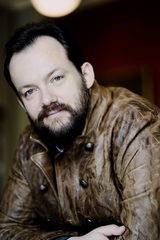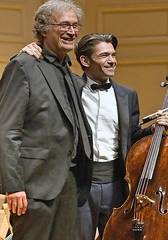|
Back
Gallic, Gorgeous (and even Gregorian) New York
Isaac Stern Auditorium, Carnegie Hall
04/24/2023 - & April 13, 14, 15, 2023 (Boston)
Maurice Ravel: Alborada del gracioso
Thierry Escaich: Les Chants de l’aube (Cello Concerto No. 2)
Sergei Rachmaninoff: Symphony No. 2 in E Minor, Opus 27
Gautier Capuçon (Cellist)
Boston Symphony Orchestra, Andris Nelsons (Music Director/Conductor)

A. Nelsons (© Marco Borggreve)
“What is Music? How do you define it? Music is a calm moonlit night, the rustle of leaves in Summer. Music is the far off peal of bells at dusk! Music comes straight from the heart and talks only to the heart: it is Love! Music is the Sister of Poetry and her Mother is sorrow.”
Sergei Rachmaninoff
“I feel like a ghost wandering in a world grown alien. I cannot cast out the old way of writing and I cannot acquire the new. I have made an intense effort to feel the musical manner of today, but it will not come to me.”
Sergei Rachmaninoff
When the Boston Symphony Orchestra (BSO) comes to Carnegie Hall, one expects two elements. First, the sheer beauty of their ensemble playing. A beauty going back to their 1881 beginning. That was where New York City was an economic powerhouse, which could buy conductors like Dvorák and Tchaikovsky. Boston, though, was the home of “art” (yucky) and their orchestra showed it.
Besides their sound, the BSO, from the time of Koussevitzky and Monteux, was happy to premiere contemporary music. Especially–hurtling away from the German classics–music of Russia and France.
Both countries were featured last night with the BSO led by its Music Director Andris Nelsons. It started with an eight‑minute Ravel masterwork, and a one‑hour Russian masterpiece. The two were composed five years apart–but what a difference in sound.
Ravel, not a great pianist himself, orchestrated his music with the colors of a Matisse or Renoir. Mr. Nelsons obviously loved the color more than the subtle Iberian rhythms. The bassoon solo, the fragments of string playing to the joyous finale, he kept the BSO on a tight leash, showing radiance more than rhythms.

T. Escaich, G. Capuçon (© Hilary Scott/Boston Symphony Orchestra)
The New York premiere–certainly the most interesting work–was a Cello Concerto by Thierry Escaich played with typical mastery by Gautier Capuçon. Its title and three movements eschewed the typical directions here. The name (in English) “Songs of the Dawn”, the movements “Of Rays and Shadows”. “Riverbanks of Songs” and “Dance of Dawn”. (No relation to Ravel’s “Jester’s Dance of Dawn.”) Each movement tied to cadenza for the soloist.
One could, of course, follow the detailed program notes, depicting a vitraux, sound layering, a peaceful song. But this piece was too complex for words. And it was more fun to hear Mr. Capuçon, its dedicatee, with whirling strings, with the sounds of African music (and a hint of Gregorian chant) and finally the colors of high and low registers, a thesaurus of cello sounds in a gorgeous painting of auras, hues and musical shapes.
The intermission was as time to ponder that work. The second half posed one question. How, after, Mr. Nelson’s riveting performance of Sergei Rachmaninoff’s most popular symphony could anybody–including the composer–have cut this hour‑long work down to fit “normal” size? That was customary until a few decades ago. And while Rachmaninoff went along with the abridgement, he confessed that with each cut, “I felt a cut in my heart.”
He needn’t have worried last night. While six dull wretches in the audience walked out, the rest of us were held by a conducting which was careful, sure, meticulous and caught all the inferences and nuances of the composer.
One hardly can compare the composer to Gustav Mahler (who wrote his own Ninth Symphony the same year), yet Mr. Nelsons conducted the start with the same hints, the same dark promises of grander music to come.
And come it did. While the work had its exceptional moments–the long clarinet solo by William R. Hudgins, that carnival opening (that’s how Petrushka would have sounded if Stravinsky had been less manic)–, and of course the lush opening of the third movement.
Andris Nelsons conducted without mania, without urgency. Rather, he stressed those long romantic passages, he left room for the (usually hidden) Dies Iræ measure.
Did he linger in the first movement? Perhaps. But in such a lengthy work, perhaps he wanted his audience to accustom themselves to all of Rachmaninoff’s own feelings. And where one inevitably waits for a Rachmaninoff piano to start singing, Mr. Nelsons, now in his ninth year as Music Director, obviously wanted to show off his Boston Symphony.
And for good reason. The members had been shaped to brilliance by Seiji Ozawa–but their Russia‑ness, their iconoclastic color came from their years with Serge Koussevitzky. He might have conducted with more passion, more urgency, but Andris Nelsons allowed us to hear Rachmaninoff at his most inspired.
The result was 60‑odd minutes of emotion, reflection, and the inevitable dazzling finale bringing the ineluctably audience to its feet.
Harry Rolnick
|